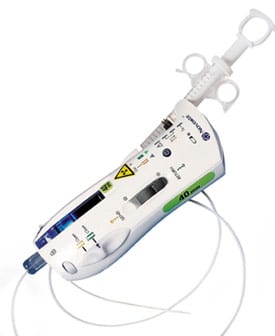Intravascular Brachytherapy
Selected Readings
AAPM TG-60: Intervascular Brachytherapy Physics (external link)
AAPM TG-149: Dose Calculation Formalisms and Consensus Dosimetry Parameters for Intravascular Brachytherapy Dosimetry (external link)
Overview
Intravascular brachytherapy is used as a treatment for restenosis and recurrent arterial blockage following angioplasty or stenting of a blocked artery. This technique is effective for blockages that are resistant to drug infuse stents or anti-coagulant (anti-clotting) drugs.
Treatment Regimen
- Prescription: 15-20Gy typically prescribed at 2mm from the source (intracoronary) or 2mm beyond lumen radius (peripheral arteries).
- Treated volume: a 2-5cm length of artery to a depth of between 0.5 and 2mm beyond the lumen.
- Dose rate:
- 1-5cGy/hour for radioactive stents
- >5Gy/minute for HDR afterloader type deliveries
- Dosimetry: follows the conventions of TG-43 (internal link)
- This is the recommendation of TG-149.
Balloon Angioplasty Procedure
Balloon angioplasty is a treatment of stenosis or narrowing of the blood vessels, especially those supplying the heart. During the treatment, a catheter is inserted into the femoral (at groin) or radial artery (at wrist) and guided to the affected artery. Once in location, a balloon is repeatedly filled and drained unclogging the artery. A stent (mesh reinforcement) is inserted to the artery to prevent future narrowing and support weakened arteries.
Restenosis may occur after an angioplasty procedure due either to blood clotting or neointimal (scar tissue) growth within the vessel. Anticlotting drugs can be used to prevent clots and drug eluding stents (DES) prevents some neointimal growth. However, restenosis may still occur due to neointimal growth and intravascular brachytherapy can be an effective treatment for such cases.
Key Point: Radioactive devices compete with Drug Eluding Stents (DES) to prevent restenosis. DES are popular as they are both effective and simple to use clinically. However, DES have difficulty delivering drugs in areas of repeat stenting. Both Beta-Cath and activated stents are regaining popularity for repeat treatments as they overcome this limitation.
Delivery Devices
Intravascular brachytherapy is either administered using a LDR implanted mesh stent or using an HDR remote afterloader device.
Low Dose Rate Mesh Stents
Radioactive mesh stents typically use either P-32 or Y-90, both of which are beta emitters.
Intravascular Afterloaders
Beta-Cath
- Sr-90/Y-90 (beta emitter)
- Sr-90 Half-life = 28.8 years
- Y-90 Half-life = 64.1 hours
- Handheld hydraulically activated afterloader
RADIANT (liquid filled balloons)
- Re-188 (beta emitter) liquid source injected into angioplasty balloon.
Additionally, several historical products are no longer available in the US market. These include:
Cordis CHECKMATE (No Longer Marketed, 2003)
- Ir-192 (gamma emitter) ribbon
- 3mm by 0.5mm seeds separated by 1mm
- Variable source length 19-80mm
- Cart mounted mechanical hand crank afterloader
Guidant GALILEO (No Longer Marketed, 2004)
- P-32 (beta emitter) enclosed in a spiral balloon around the central wire
- Spiral design improves line flexibility
- Remotely controlled by motorized afterloader device
Additional Considerations
Beta Vs Gamma Emitters
Beta emitting devices have the advantage of a higher dose rate and more localized dose distributions relative to gamma emitters but produce a less uniform dose distribution. The dose distribution within the treated area (~2mm) is essentially the same for both gamma and beta sources because of the dominance of inverse square law. Both beta and gamma emitting isotopes are considered adequate for intravascular brachytherapy although Khan notes a preference for Beta emitters.
LDR (Radioactive Stents) Vs HDR
LDR intravascular brachytherapy is a relatively simple procedure in that it entails essentially the same steps as a standard stent placement. Further, the low dose rate of the stent makes the procedure safer for radiation workers than many of the HDR approaches. However, use of radioactive stents has fallen out of favor due to “candy wrapper effect” in which restenosis forms at the ends of a LDR stent.
Navigation
Not a Member?
Sign up today to get access to hundreds of ABR style practice questions.




